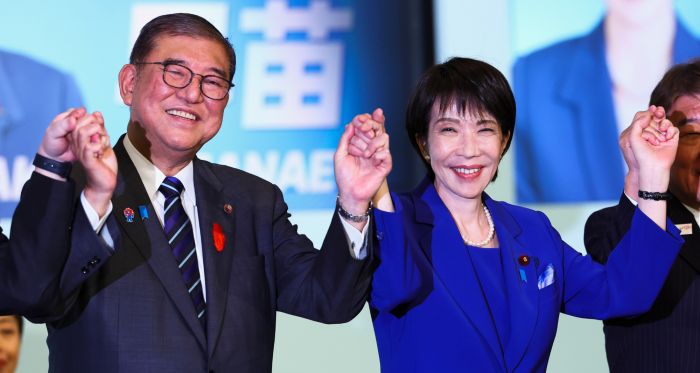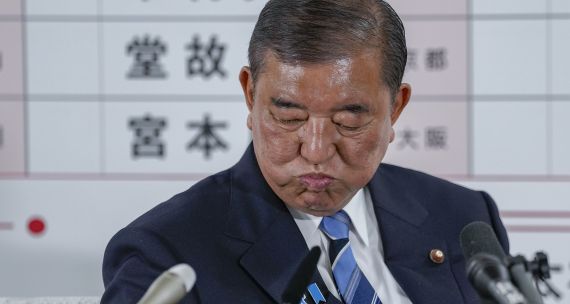À retenir
Le Parti libéral démocrate (PLD) au pouvoir au Japon a élu Takaichi Sanae, une conservatrice pure et dure, à sa tête le 4 octobre. Sa victoire survient alors que le PLD est aux prises avec une perte de confiance du public, une flambée du coût de la vie et des revers sans précédent lors des récentes élections.
Dans la conférence de presse qui a suivi sa victoire auprès du parti, Mme Takaichi a promis de s’attaquer à la crise du coût de la vie et de réaffirmer l’alliance du Japon avec les États-Unis. Elle a également atténué ses remarques précédentes sur la révision d’un accord commercial bilatéral récemment conclu avec Washington. Toutefois, sa réputation de révisionniste de l’histoire de la guerre et de détractrice de la Chine indique que le PLD, sous la direction de Mme Takaichi, pourrait s’éloigner du pragmatisme plus centriste de ses prédécesseurs récents.
Si le parlement confirme l’élection de Takaichi Sanae comme prévu, elle entrera dans l’histoire en tant que première femme à devenir première ministre japonaise.
En bref
- Takaichi Sanae, 64 ans, ancienne ministre de la Sécurité économique et des Affaires intérieures, se situe à la droite du PLD et est une protégée du défunt premier ministre japonais Abe Shinzo. Elle s’est engagée à relancer son programme « Abenomics » ayant pour objectif une politique monétaire expansionniste agressive, la relance budgétaire et des réformes structurelles pour stimuler la croissance économique, tout en mettant l’accent sur la sécurité économique et la défense.
- Le soutien apporté à Mme Takaichi par d’autres membres du PLD souligne le penchant du parti pour la stabilité et la continuité idéologique au détriment du renouvellement par la réforme. En élisant Mme Takaichi, les élites du parti ont opté pour la prévisibilité dans un contexte de crise, réaffirmant l’influence de la « faction Abe » plutôt que de répondre à l’appel de Koizumi Shinjiro, 44 ans, à un changement de génération. Alors que de nombreux membres de la Diète ont soutenu M. Koizumi au premier tour, le vote préfectoral (hors parlement, membres de base) a favorisé Mme Takaichi. Son ascension reflète l’anxiété du PLD face à la montée des partis populistes de droite et la méfiance croissante du public que ces mouvements ont exploitée.
- Takaichi Sanae fera l’objet d’un vote de confirmation à la Diète, le parlement du pays, à la fin du mois. La coalition PLD-Komeito au pouvoir, affaiblie par la colère publique en raison de la flambée des prix et de la stagnation des revenus, n’a actuellement pas la majorité à la Chambre basse ni à la Chambre haute. Lors des élections de juillet dans la Chambre haute, les partis de droite ont gagné du terrain en promettant des réductions d’impôts immédiates et des contrôles plus stricts de l’immigration. On ne sait toujours pas si les partis d’opposition se rallieront à un autre candidat au poste de premier ministre.
Les conséquences
Le PLD semble calculer que le populisme conservateur est le meilleur moyen d’apaiser le mécontentement de la population. Des années de stagnation des salaires et de hausse des prix ont érodé la confiance du public dans le parti au pouvoir au Japon, entraînant d’importantes pertes électorales. Mme Takaichi promet maintenant un « Abenomics 2.0 », combinant réductions d’impôts, subventions et dépenses agressives pour alléger le fardeau de l’inflation, tout en affirmant « l’importance de la prudence budgétaire ». Elle a critiqué les récentes hausses des taux d’intérêt de la Banque du Japon et signalé un retour à des dépenses expansionnistes pour aider les ménages japonais à « reprendre espoir ». Les investisseurs restent toutefois prudents. La hausse des dépenses qu’elle propose pourrait aggraver la dette du Japon et affaiblir le yen.
La victoire de Takaichi Sanae représente une continuité idéologique plutôt qu’une transformation. En tant que première femme première ministre en voie d’entrer en fonction au Japon, son leadership est historique, mais sa politique reste ancrée dans la vieille garde conservatrice du parti. Son opposition aux noms de famille distincts pour les couples mariés et sa défense limitée de l’équité entre les sexes ont conduit certains observateurs à la qualifier de « symbole de progrès sans réforme ». Au sein du PLD, elle doit gérer les rivalités entre factions et continuer à coopérer avec le partenaire de coalition du PLD, Komeito, dont la base centriste résistera à une dérive vers la droite. La capacité d’unifier ces forces concurrentes déterminera si son mandat stabilise le parti ou accélère la fragmentation déjà visible parmi les conservateurs japonais.
Prochaines étapes
1. La politique de soutien à Taïwan pourrait susciter des réactions
Le leadership de Mme Takaichi marque un virage décisif vers une politique étrangère japonaise qui gagne en assurance. Il est attendu qu’elle accélère le développement des dispositifs de défense du Japon et fasse pression pour réviser la constitution afin de renforcer le rôle des Forces d’autodéfense, ce qui pourrait permettre une coopération plus approfondie en matière de sécurité avec Taïwan dans le cadre de l’alliance avec les États-Unis. Son engagement envers l’alliance avec les États-Unis, quant à lui, demeure fort; elle s’est engagée à maintenir l’accord d’investissement avec le président américain Donald Trump, selon lequel un financement japonais sera offert en échange d’une diminution des tarifs douaniers. Parallèlement, le soutien indéfectible de Mme Takaichi à Taïwan et ses positions inébranlables sur les différends territoriaux avec la Chine ainsi que sur le programme nucléaire de la Corée du Nord pourraient exacerber les tensions régionales.
2. Mise à l’épreuve probable par Beijing alors que Séoul reste optimiste, mais prudente
Beijing devrait mettre à l’épreuve la détermination de Mme Takaichi au moyen d’une pression militaire ou économique. Le président sud-coréen Lee Jae-myung a exprimé sa volonté de maintenir un « élan positif » dans les relations bilatérales, qui restent fragiles. Toute remarque incendiaire de Takaichi – ou toute nouvelle visite au sanctuaire Yasukuni, le monument controversé aux morts de la guerre du Japon – pourrait rapidement annuler les récents progrès. Bien que la potentielle future première ministre ait fait preuve de retenue dans son discours de victoire en prenant de la distance par rapport à ces visites, Beijing et Séoul sont susceptibles d’observer la façon dont elle traite les questions historiques sensibles comme indicateur de son approche diplomatique d’ensemble.
Au sujet de la région indo-pacifique, Mme Takaichi dit qu’elle vise à « voyager dans le monde pour annoncer le retour du Japon », promettant une présence diplomatique plus active et une coopération plus forte à travers le Quad (avec l’Australie, l’Inde et les États-Unis). Son approche renforcera probablement le pouvoir japonais de dissuasion, mais risque d’exacerber les tensions régionales si elle n’est pas associée à une diplomatie habile.
3. Les liens entre le Canada et le Japon devraient s’améliorer
La continuité devrait définir les relations du Canada avec Tokyo sous Mme Takaichi, Ottawa considérant le Japon comme la pierre angulaire de la Stratégie du Canada pour l’Indo-Pacifique. Il est prévu que son gouvernement continue à collaborer dans les domaines des minéraux critiques, de l’énergie propre, des technologies de pointe et de la défense. En juillet, les deux pays ont signé un accord sur la sécurité de l’information, accord historique permettant une collaboration plus étroite en matière de renseignement et de défense. L’accord facilite le partage de données classifiées et l’avancement des partenariats technologiques de défense, s’harmonisant avec les efforts du Japon pour travailler avec des démocraties aux vues similaires.
Le Canada et le Japon coopèrent déjà étroitement dans le cadre de l’Accord de Partenariat transpacifique global et progressiste (PTPGP) et partagent l’engagement de maintenir un ordre indo-pacifique fondé sur des règles. En outre, une rencontre bilatérale entre le premier ministre canadien Mark Carney et Takaichi Sanae est prévue lors du prochain sommet des dirigeants du forum de la Coopération économique Asie-Pacifique (APEC) à Gyeongju, en Corée du Sud. Les deux gouvernements devraient profiter de l’occasion pour faire avancer les discussions sur la libéralisation du commerce, la sécurité de la chaîne d’approvisionnement et la gouvernance de l’intelligence artificielle.
• Édition par Vina Nadjibulla, vice-présidente, Recherche et stratégie, FAP Canada; et Ted Fraser, rédacteur principal, FAP Canada.





